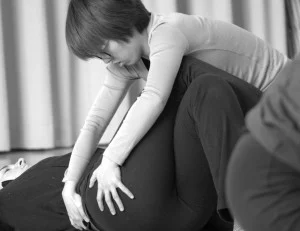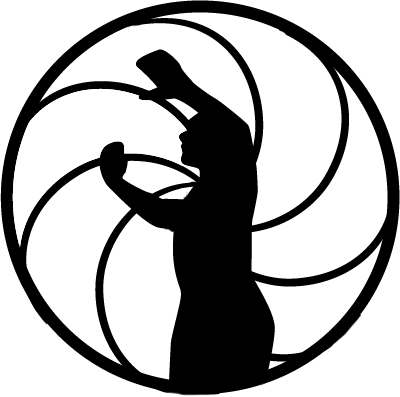5 1/2 YEAR OLD SCARLETT LEARNS HOW TO WALK OVER BLOCKS
At SMC, we work with children struggling with diverse motor impairments, from slight developmental delays to severe disabilities, and we observe one universal about them all—they are all capable of great transformation. Some children in our studio have learned how to roll, crawl or walk for the first time many years after their birth; others have learned how to focus their energy, to control their behaviour, or to play with other children when formerly they were totally unable to do so. For children, progress comes naturally. The reason? No doubt it’s due in great part because they aren’t burdened with too much experience. Children are a pure tabula rasa upon which anything can be written; they are fresh and adaptable. Once they’ve experienced and learned a new skill or behaviour (and more importantly, when they see the change is positive), they are usually quick to gather the strings of their Personality together—naturally re-tune them, so to speak—to express more beautiful sounds.
Adults, on the other hand, can often be resistant to change. We come with a large history of experience, repetitive conditionings which mars the spontaneity of our bodymind flow and renders us less flexible or free than children. Internally, these conditionings can manifest themselves as slow, inefficient reflexes, stereotyped emotional and cognitive responses to the events, anxieties and holding patterns within a self-created armature. Externally, these conditionings can manifest themselves in strict daily routines, unrelenting social pressures and education standards, or perhaps undue focus upon some profession or skill which no longer leaves room for a healthy balance between mind and body. It is not a question of competence per se—most adults possess an awareness and aptitude for bodymind techniques that children are simply not capable of. But adults, like computers which have amassed too much data, can often be shut down by their very excess of knowledge. Nowadays, it is all too easy to see that most people do not live close to their potentiality despite the fact that modern life affords so much freedom than in any other time in history. We live in an information and technologically-assisted age but the state of our bodymind is overloaded—we are incapable of utilizing the freedom that is around us because we have lost the ability to change with it.
What is the character of bodymind transformation?
This adult inflexibility towards change is the greatest hindrance towards the ideal of bodymind transformation. By bodymind transformation we don’t mean anything fantastical or mystical. Bodymind transformation is a concrete notion that describes the possibility of breaking through conditionings through somatic awareness. It is a self-guided journey that a person can undertake to return to a more flowing, transparent way of being—in short, it is a praxis. Praxis (whose root lies in the ancient Greek word for “doing") signifies the process by which a person attempts to embody their inner knowledge through daily life transformations.
Transformation can happen in a thousand ways. It occurs every time when a person has learned how to overcome a chronic injury or pain. It occurs every time a person is able to re-pattern their emotional response to situations. It occurs every time a person is able to find a greater degree of freedom in the way they move or express themselves. Bodymind transformation often occurs as a moment of self-revelation— it has the character of a sudden epiphany that comes spontaneously as a person realizes, “yes I can do this.” It is not usually a single moment but a series of moments, each being a milestone, a culmination of a long spiral process of discovery that involves many repeated somatic experiences that have suddenly coalesced and become whole.
Some examples of bodymind transformation in Spiral Praxis
Spiral Praxis can tremendously help people learn how to return to a child-like state because it systematically allows people to go to the foundations of how we think, feel, act and move. It works on a holistic principle, employing a simple but deep theoretical framework which considers the entire spectrum of internal phenomena within us—our senses, organ perceptions, thoughts, feelings, modes of cognitive organization and so on. Somatics is the art of creating experiential transformations—in Spiral Praxis, we follow four developmental stages to encourage this process as shown in the diagram below:
(1) Relaxation: Releasing Tension & Pain
In Spiral Praxis, the first step of transformation is to release tensions or pains within the bodymind. We call this process “zeroing out.” To release holding patterns, pains, tensions, anxieties, involves the ability of persons to, first and foremost, become aware of these blocks and learn how to re-shape them internally. In Spiral Praxis we achieve this by using intervals of awareness. Intervals of awareness are short, intense meditations that focus on various parameters of a holding pattern. For example, we might focus on the energy pitch, shape and texture, location, and other properties of a block. Using more advanced techniques called internal flow patterning, we can start to modify the original interval of awareness to resolve the holding pattern. The key in Spiral Praxis is that we can very accurately zero out blocks quickly and this baseline allows the bodymind’s natural healing mechanisms to activate.
(2) Exploration: Expanding Experiences
In Spiral Praxis, the second step of transformation involves creating a large foundation of new bodymind experiences to encourage learning and growth. We call his exploratory stage “gathering primary experiences.” In order to achieve this process of exploration, a Spiral Praxis practitioner will encourage clients to approach new experiences through a rich tapestry of variations. Experiences are presented through the full spectrum of somatic experience—tactile, kinaesthetic, visual, auditory, organ systems—and these are variated through what we call “learning reflexes." Learning reflexes allow people to rapidly accelerate the process of embodiment.
(3) Reinforcing & Challenging Embodiment
In Spiral Praxis, the third step of transformation is creating an environment of praxis—the testing of newly found skills in new and challenging contexts. For example, if a person has learned how to quiet their mind through somatic SP techniques, they need to be able to generalize this skill in different situations that they might encounter in life—in public situations, in different activities, under different environmental conditions. In Spiral Praxis we encourage our students and clients to test their somatic ability by actively creating embodiment projects. Embodiment projects are freely chosen challenges that a person sets for themselves to demonstrate their own self-competence and self-mastery.
(4) Flow and Integration: Reaching Resonance
In the final phase of transformation, there is a shift of emphasis from the conscious to the unconscious, since truly embodied skills must become totally reflexive. This is the moment when transformative experiences attain their greatest height. When this happens, moments of transformation are experienced in deep insight or “resonance states.” These states are similar to the states attained by meditators when they reach moments of complete calm and emptiness, with the difference that resonance states can also be achieved in vigorous and active states as well.
And here are examples of transformation of people who come through our studio:
A woman is having trouble relaxing because she has three young children and many work-related pressures. She has tried other modalities to relax—massage, hypnosis, acupuncture—to relieve her stress but has found that her relaxation is dependent on visits to her therapist. She feels good for a few days after treatment but then slowly reverts back to her habitual patterns of tension. In Spiral Praxis she learns how to create states of relaxation through meditations on her organ systems and breathing exercises. Through these techniques—short, burst-like meditations which she can do during the day on her own— she is able to lessen her emotional state and dramatically improve the symptoms of that were related to her stress level (i.e. pain and bleeding in her pelvic region, lower back pain, skin rashes that occur during stress).
A man is having difficulty with raising his arm over his head, experiencing great pain when he tries to do so. He is unable to lift his arms off the floor even while lying down. He has torn a major nerve in his pectoral region while playing basketball and the muscles in that region have visibly atrophied. Doctors have suggested an operation to reattach the nerves—being older, this suggestion does not agree with him. Rather than have surgery he is looking for a natural option. Through Spiral Praxis, he is able to learn how to recruit what muscles are still active through a process of movement re-education. This process is filled with self-guided activities that he can do at home and, after 8 sessions, he is able to lift 10 pounds of weight over his head without pain allowing him to resume his normal lifestyle.
A 10-year old child has cerebral palsy and autism and has not been able to crawl since he was born. He has taken physical therapy, swimming, occupation therapy with limited success—none of these therapies can individualize his treatment sufficiently to allow him to recover his motor potential. Through Spiral Praxis, we are able to lead him through all the steps of rehabilitation, beginning with restoring mobility in his limbs (through intensive bodywork and body awareness activities), and progressing through the subsequent phases of movement re-education (muscle re-patterning, strengthening and coordinating), all through highly individualized therapy geared towards his specialized learning abilities. He is now able to crawl around at home and is beginning the process of learning how to walk.
All these stories represent cases of beautiful human transformation—the ability of the bodymind to overcome obstacles through developmentally-guided somatic exploration and embodiment.
How can somatic transformation change the way we approach life?
Transformation through bodymind awareness is an area that has traditionally been reserved for religious aspirants, martial artists, occultists, and other minority sects of society. The world has never seen schools of bodymind training for the general run of society. Why is that the case? Why has bodymind training been largely an esoteric education, taken up only by a the few? Perhaps it is because in former times, bodymind training was considered an arduous, slow process that demanded intensive, life-long dedication from it’s practitioners. In ancient texts from the East, we are regaled with tales of yogis who would meditate for hours and days on end; and even now, we can observe that the training for traditional bodymind practitioners—say of contemporary Tibetan monks, for example—still involve an extremity of study that would be beyond the reach of the general lay person. For whatever reason, we have grown used to the notion that internal transformation is difficult and arduous, taking a lifetime of study and, in some traditions, even more than one lifetime!
Is this notion still true? While it is certain that bodymind exploration is vast enough to keep a practitioner busy for his/her entire life, it is equally true that the gains to be made by modern bodymind systems are faster than ever. Perhaps the most exciting aspect of Spiral Praxis and other contemporary bodymind systems like it is their ability to bring people to resonance flow experiences in many activities—from meditation, yoga, fitness, music, climbing, dancing—in a very short amount of time.
At SMC, people have used Spiral Praxis to recover from injury, to improve their memory, to gain emotional control, to improve their fitness and many other aspects of human functioning in short periods of training. The reason why for this versatility is because Spiral Praxis is grounded upon simple universal bodymind principles; in short, what is present and possible in all human beings at all times. The capabilities we uncover during the somatic process are no different than the ones that we learn in childhood and what Spiral Praxis allows people to do is to simply extend the learning capabilities of childhood into our adult life, with the full sophistication of our adult understanding and competence. This, we believe, is a new and contemporary vision for human functioning and a very important one. Bodymind transformation—in the physical, mental, emotional, social dimension— is a crucial factor as we enter into the very swift currents of the 21st century, for we as human beings will either learn to embody the dynamics of transformation and swim in these vigorous currents or else be paralyzed and drowned by their rapidity.






